The Effect of Direct-to-Plant Styrene-Butadiene-Styrene Block Copolymer Components on Bitumen Modification
Abstract
:1. Introduction
2. Raw Materials
2.1. Raw Materials of Direct-to-Plant SBS
2.2. Preparation Process of Direct-to-Plant SBS
2.3. Preparation Process of Modified Bitumen by Direct-to-Plant SBS
2.4. Bitumen, Aggregate and Mineral Powder
2.5. Preparation Process of the Modified Bituminous Mixture by Direct-to-Plant SBS
3. Test Design
4. Microstructure Analysis
4.1. Micro-Images Processing Method of Direct-to-Plant SBS Modified Bitumen
- All RGB images are set to 254 × 192 pixels.
- Command: A = imread(‘C:\Users\z3525296\Desktop\1\9#.jpg’)%;
- Set level = 0.55;
- Command: B = im2bw(A, 0.55)%;
- Selected ‘skel’ morphological operation and ‘Inf’ (Infinite) operation.
- Command: C = bwmorph(B, ‘skel’, Inf)%;
- Command: X = bwarea(A)%
- Command: Y = bwarea(B)%
- Command: Z = x/y%
4.2. Micro-Images of Direct-to-Plant SBS Modified Bitumen
4.3. Analysis and Calculation on Microscopic Images of Direct-to-Plant SBS Modified Bitumen
5. Macroscopic Test Results and Analysis
5.1. Melting Point
5.2. Melting Index
5.3. Performances of Modified Bitumen Using Direct-to-Plant SBS
5.4. Performances of the Modified Bituminous Mixture Using Direct-to-Plant SBS
6. The Range of the Key Component
7. Conclusions
Author Contributions
Funding
Conflicts of Interest
References
- Hou, Y.Q.; Ji, X.P.; Li, J.; Li, X.H. Adhesion between asphalt and recycled concrete aggregate and its impact on the properties of asphalt mixture. Materials 2018, 11, 2528. [Google Scholar] [CrossRef] [PubMed]
- Behnood, A.; Olek, J. Rheological properties of asphalt binders modified with styrene-butadiene-styrene (SBS), ground tire rubber (GTR), or polyphosphoric acid (PPA). Construct. Build. Mater. 2017, 151, 464–478. [Google Scholar] [CrossRef]
- Li, J.; Han, M.; Muhammad, Y.; Liu, Y.; Su, Z.; Yang, J.; Yang, S.; Duan, S. Preparation and Properties of SBS-g-GOs-Modified Asphalt Based on a Thiol-ene Click Reaction in a Bituminous Environment. Polymers 2018, 10, 1264. [Google Scholar] [CrossRef]
- Zedler, Ł.; Klein, M.; Saeb, M.; Colom, X.; Cañavate, J.; Formela, K. Synergistic effects of bitumen plasticization and microwave treatment on short-term devulcanization of ground tire rubber. Polymers 2018, 10, 1265. [Google Scholar] [CrossRef]
- Yang, Z.; Zhang, X.; Zhang, Z.; Zou, B.; Zhu, Z.; Lu, G.; Xu, W.; Yu, J.; Yu, H. Effect of aging on chemical and rheological properties of bitumen. Polymers 2018, 10, 1345. [Google Scholar] [CrossRef]
- Xia, T.; Xu, J.; Huang, T.; He, J.; Zhang, Y.; Guo, J.; Li, Y. Viscoelastic phase behavior in SBS modified bitumen studied by morphology evolution and viscoelasticity change. Construct. Build. Mater. 2016, 105, 589–594. [Google Scholar] [CrossRef]
- Laukkanen, O.V.; Soenen, H.; Winter, H.H.; Seppälä, J. Low-temperature rheological and morphological characterization of SBS modified bitumen. Construct. Build. Mater. 2018, 179, 348–359. [Google Scholar] [CrossRef]
- Fazaeli, H.; Amini, A.A.; Nejad, F.M.; Behbahani, H. Rheological properties of bitumen modified with a combination of FT paraffin wax (sasobit®) and other additives. J. Civ. Eng. Manag. 2016, 22, 135–145. [Google Scholar] [CrossRef]
- Rossi, C.O.; Spadafora, A.; Teltayev, B.; Izmailova, G.; Amerbayev, Y.; Bortolotti, V. Polymer modified bitumen: Rheological properties and structural characterization. Colloids Surfaces A Physicochem. Eng. Asp. 2015, 480, 390–397. [Google Scholar] [CrossRef]
- Yu, J.; Ren, Z.; Yu, H.; Wang, D.; Svetlana, S.; Korolev, E.; Guo, F. Modification of Asphalt Rubber with Nanoclay towards Enhanced Storage Stability. Materials 2018, 11, 2093. [Google Scholar] [CrossRef]
- Niu, Y.; Zhu, Z.; Xiao, J.; Liu, Z.; Liang, B. Evaluation of storage stability of styrene–butadiene–styrene block copolymer-modified asphalt via electrochemical analysis. Construct. Build. Mater. 2016, 107, 38–43. [Google Scholar] [CrossRef]
- Sugano, M.; Kajita, J.; Ochiai, M.; Takagi, N.; Iwai, S.; Hirano, K. Mechanisms for chemical reactivity of two kinds of polymer modified asphalts during thermal degradation. Chem. Eng. J. 2011, 176, 231–236. [Google Scholar] [CrossRef]
- Mothé, M.G.; Leite, L.F.; Mothé, C.G. Thermal characterization of asphalt mixtures by TG/DTG, DTA and FTIR. J. Therm. Anal. Calorim. 2008, 93, 105–109. [Google Scholar] [CrossRef]
- Bonati, A.; Merusi, F.; Polacco, G.; Filippi, S.; Giuliani, F. Ignitability and thermal stability of asphalt binders and mastics for flexible pavements in highway tunnels. Construct. Build. Mater. 2012, 37, 660–668. [Google Scholar] [CrossRef]
- Guolu Gaoke Engineering Technology Institute Co., Ltd. Technical Guideline for Construction of Direct-to-Plant SBS Modified Bituminous Pavement T/CHTS 20003-2018; China Communications Press: Beijing, China, 2018. (In Chinese) [Google Scholar]
- Al-Rabiah, A.A.; Abdelaziz, O.Y.; Montero, E.M.; Aazam, M.S. Effect of styrene–butadiene–styrene copolymer modification on properties of Saudi bitumen. Pet. Sci. Technol. 2016, 34, 321–327. [Google Scholar] [CrossRef]
- Kaymanesh, M.R.; Ziari, H.; Damyar, B. Effect of waste EVA and waste CR on high temperature performance of bitumen. Pet. Sci. Technol. 2017, 35, 1537–1541. [Google Scholar] [CrossRef]
- Lu, H.; Ye, F.; Yuan, J.; Yin, W. Properties comparison and mechanism analysis of naphthenic oil/SBS and nano-MMT/SBS modified asphalt. Construct. Build. Mater. 2018, 187, 1147–1157. [Google Scholar] [CrossRef]
- Pyshyev, S.; Gunka, V.; Grytsenko, Y.; Shved, M.; Kochubei, V. Oil and gas processing products to obtain polymers modified bitumen. Int. J. Pavement Res. Technol. 2017, 10, 289–296. [Google Scholar] [CrossRef]
- Bissada, K.A.; Tan, J.; Szymezyk, E.; Darnell, M.; Mei, M. Group-type characterization of crude oil and bitumen. Part II: Efficient separation and quantification of normal-paraffins iso-paraffins and naphthenes (PIN). Fuel 2016, 173, 217–221. [Google Scholar] [CrossRef]
- Zhang, W.G.; Ding, L.T.; Jia, Z.R. Design of SBS-Modified Bitumen Stabilizer Powder Based on the Vulcanization Mechanism. Appl. Sci. 2018, 8, 457. [Google Scholar] [CrossRef]
- Zhang, W.G.; Shi, J.; Jia, Z.R. The UV anti-aging performance of TPS modified bitumen. Pet. Sci. Technol. 2018, 36, 1164–1169. [Google Scholar] [CrossRef]
- Zhao, Z.J.; Xu, S.; Wu, W.F.; Yu, J.Y.; Wu, S.P. The Aging Resistance of Asphalt Containing a Compound of LDHs and Antioxidant. Pet. Sci. Technol. 2015, 33, 787–793. [Google Scholar] [CrossRef]
- Wang, P.; Zhai, F.; Dong, Z.J.; Wang, L.Z.; Liao, J.P.; Li, G.R. Micromorphology of asphalt modified by polymer and carbon nanotubes through molecular dynamics simulation and experiments: Role of strengthened interfacial interactions. Energy Fuels. 2018, 32, 1179–1187. [Google Scholar] [CrossRef]
- Jelčić, Ž.; Ocelić Bulatović, V.; Jurkaš Marković, K.; Rek, V. Multi-fractal morphology of un-aged and aged SBS polymer-modified bitumen. Plast. Rubber Compos. 2017, 46, 77–98. [Google Scholar] [CrossRef]
- Dong, F.; Yu, X.; Liu, S.; Wei, J. Rheological behaviors and microstructure of SBS/CR composite modified hard asphalt. Construct. Build. Mater. 2016, 115, 285–293. [Google Scholar] [CrossRef]
- Falchetto, A.C.; Moon, K.H.; Wistuba, M.P. Microstructural analysis and rheological modeling of asphalt mixtures containing recycled asphalt materials. Materials 2014, 7, 6254–6280. [Google Scholar] [CrossRef] [PubMed]
- Guo, W.; Guo, X.; Chang, M.; Dai, W. Evaluating the Effect of Hydrophobic Nanosilica on the Viscoelasticity Property of Asphalt and Asphalt Mixture. Materials 2018, 11, 2328. [Google Scholar] [CrossRef] [PubMed]
- Hu, K.; Han, S.; Liu, Z.; Niu, D. Determination of morphology characteristics of polymer-modified asphalt by a quantification parameters approach. Road Mater. Pavement Des. 2018, 1–16. [Google Scholar] [CrossRef]
- Doğan, M.; Bayramli, E. Effect of polymer additives and process temperature on the physical properties of bitumen-based composites. J. Appl. Polym. Sci. 2009, 113, 2331–2338. [Google Scholar] [CrossRef]
- Galooyak, S.S.; Dabir, B.; Nazarbeygi, A.E.; Moeini, A. Rheological properties and storage stability of bitumen/SBS/montmorillonite composites. Construct. Build. Mater. 2010, 24, 300–307. [Google Scholar] [CrossRef]
- Xia, T.; Zhou, L.; Xu, J.; Qin, Y.; Chen, W.; Dai, J. Rheology and thermal stability of polymer modified bitumen with coexistence of amorphous phase and crystalline phase. Construct. Build. Mater. 2018, 178, 272–279. [Google Scholar] [CrossRef]
- The Ministry of Communications Highway Science Institute. Technical Specification of Construction of Highway Asphalt Pavement; JTG F40-2004; China Communications Press: Beijing, China, 2004. (In Chinese) [Google Scholar]
- The Ministry of Communications Highway Science Institute. Test Methods of Aggregate for Highway Engineering; JTG E42-2005; China Communications Press: Beijing, China, 2005. (In Chinese) [Google Scholar]
- The Ministry of Communications Highway Science Institute. Standard Test Methods of Bitumen and Bituminous mixtures for Highway Engineering; JTG E20-2011; China Communications Press: Beijing, China, 2011. (In Chinese) [Google Scholar]
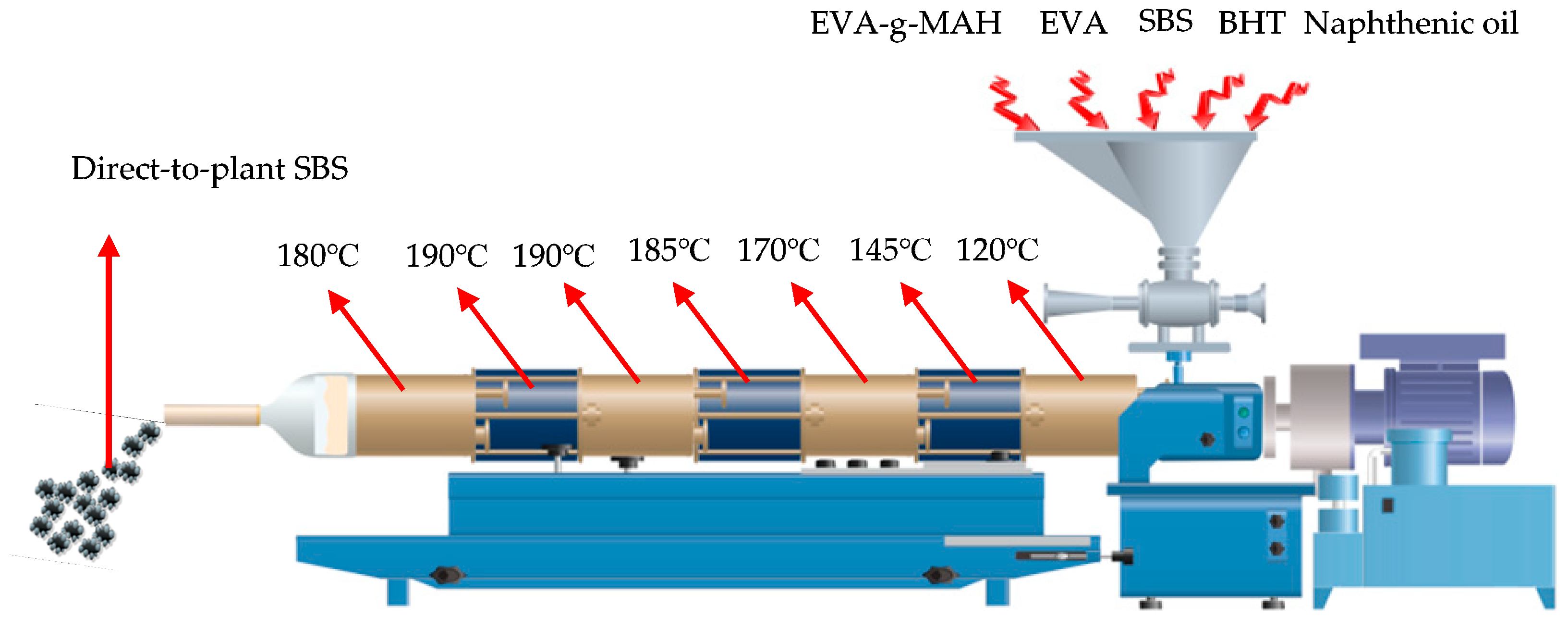
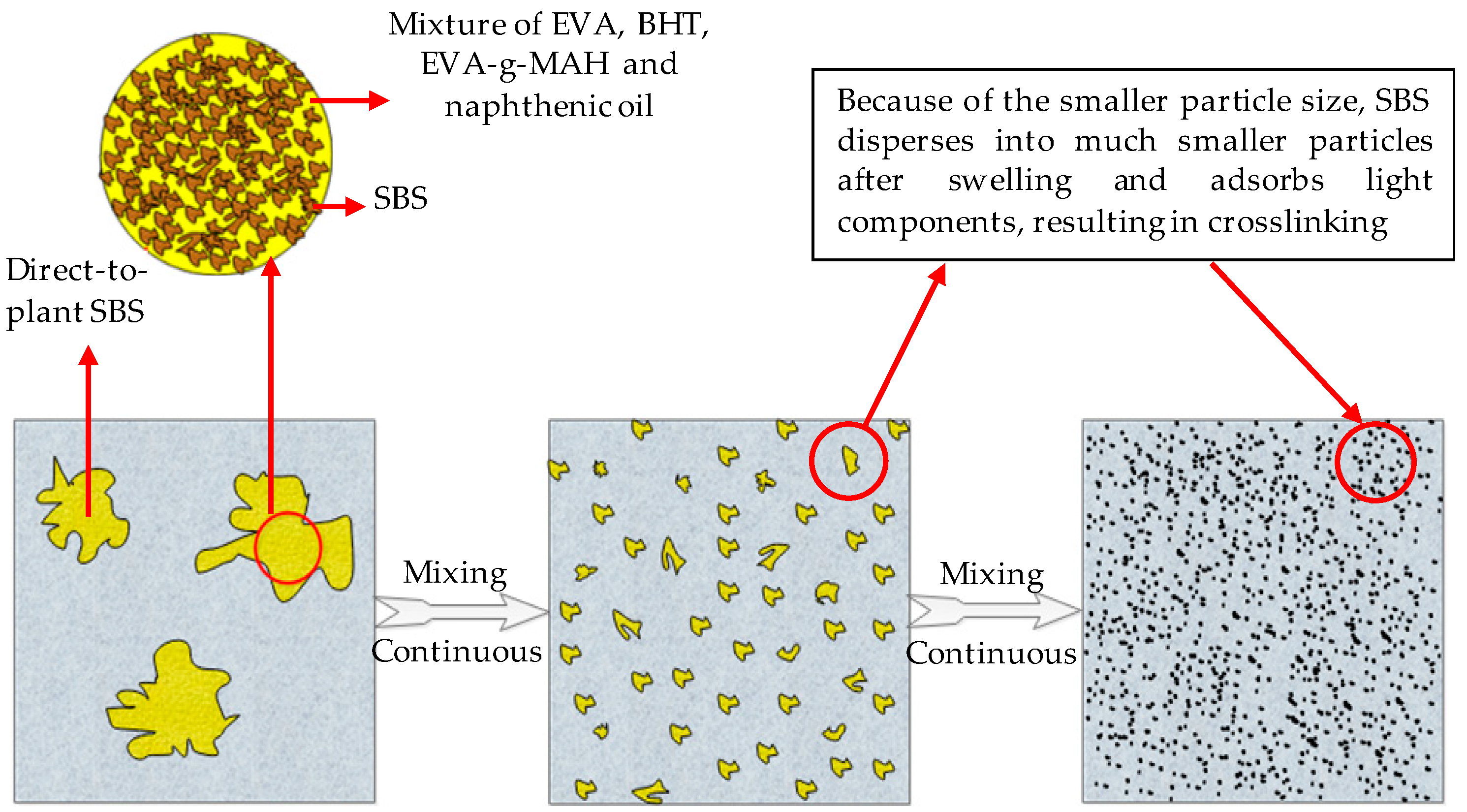


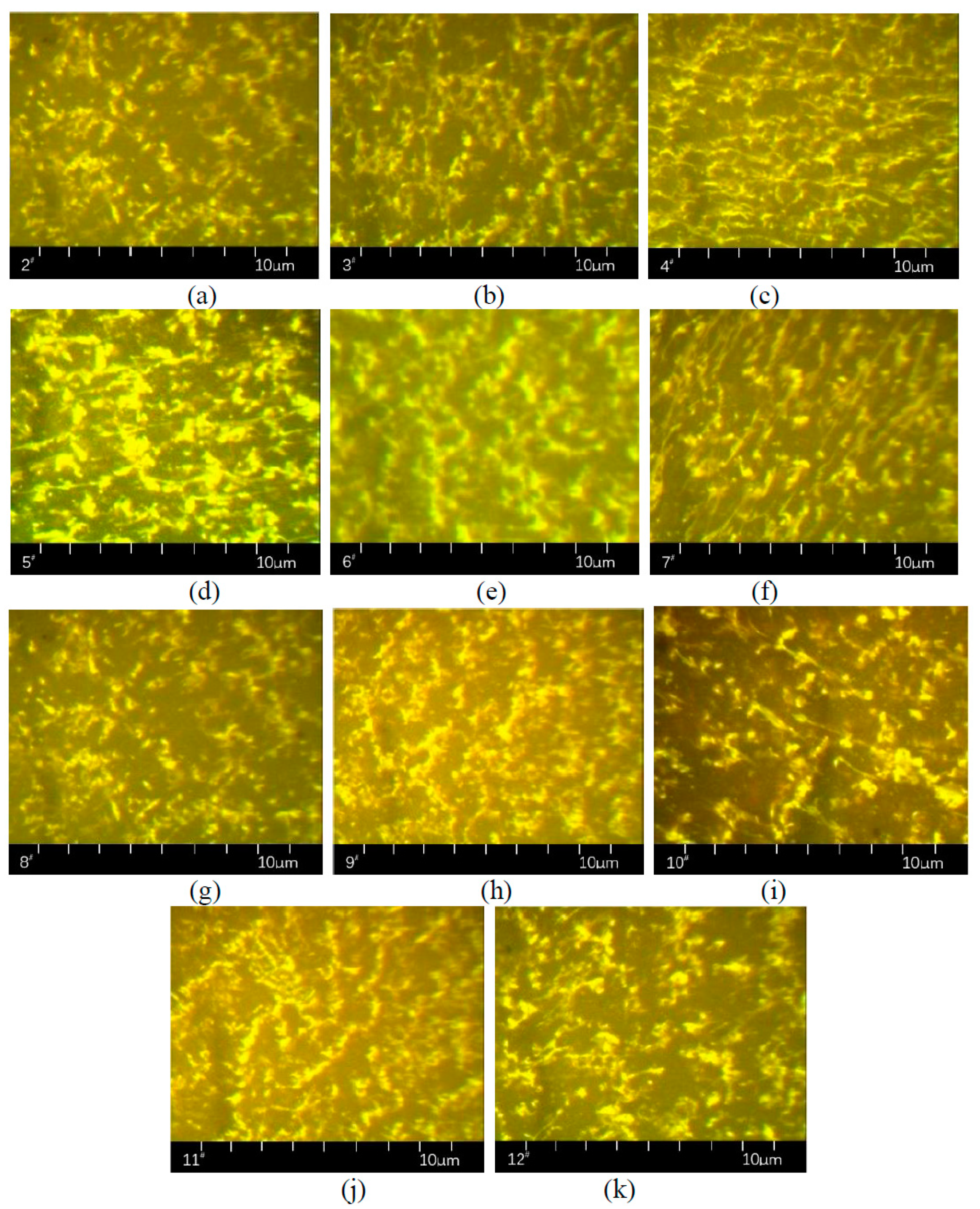
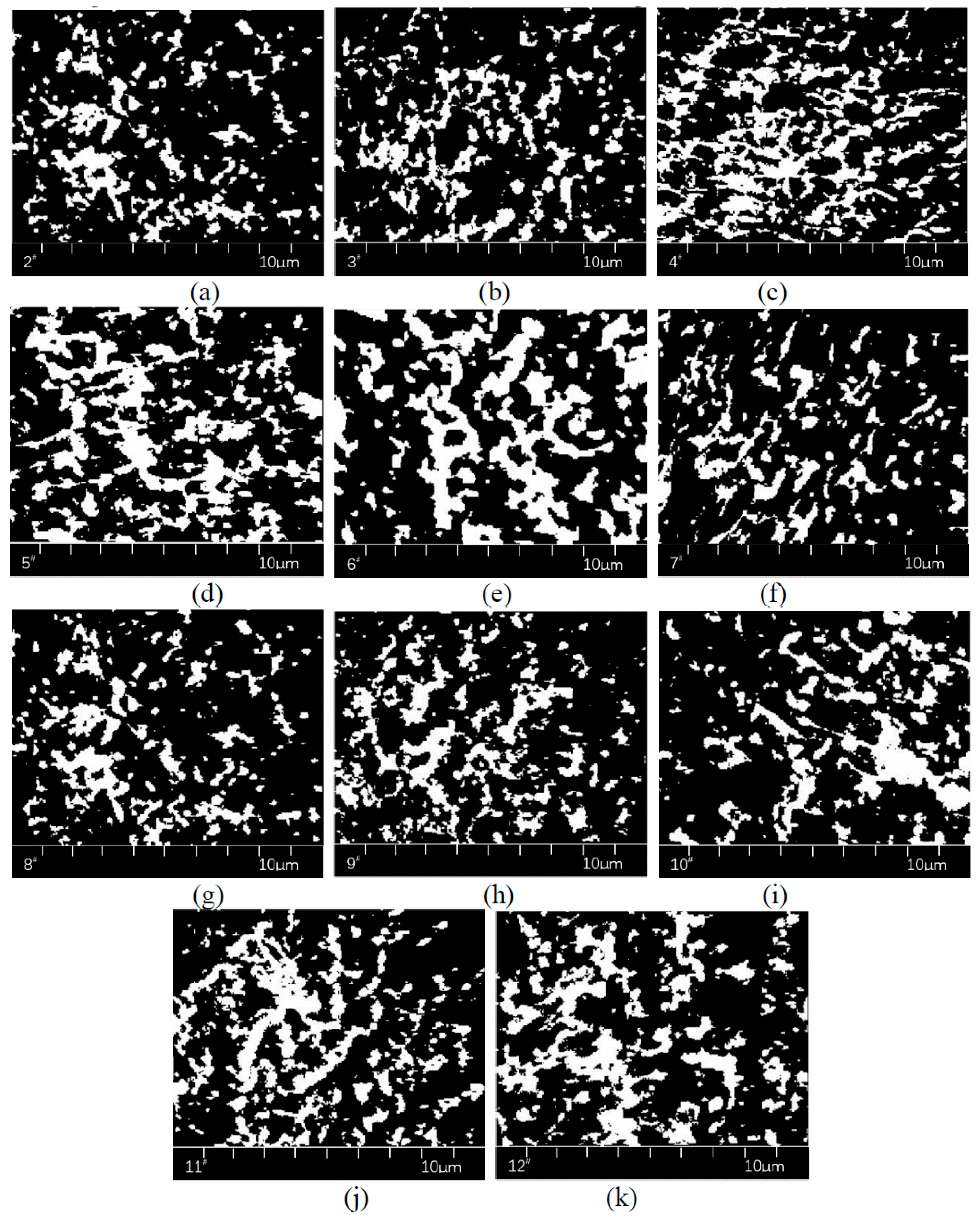


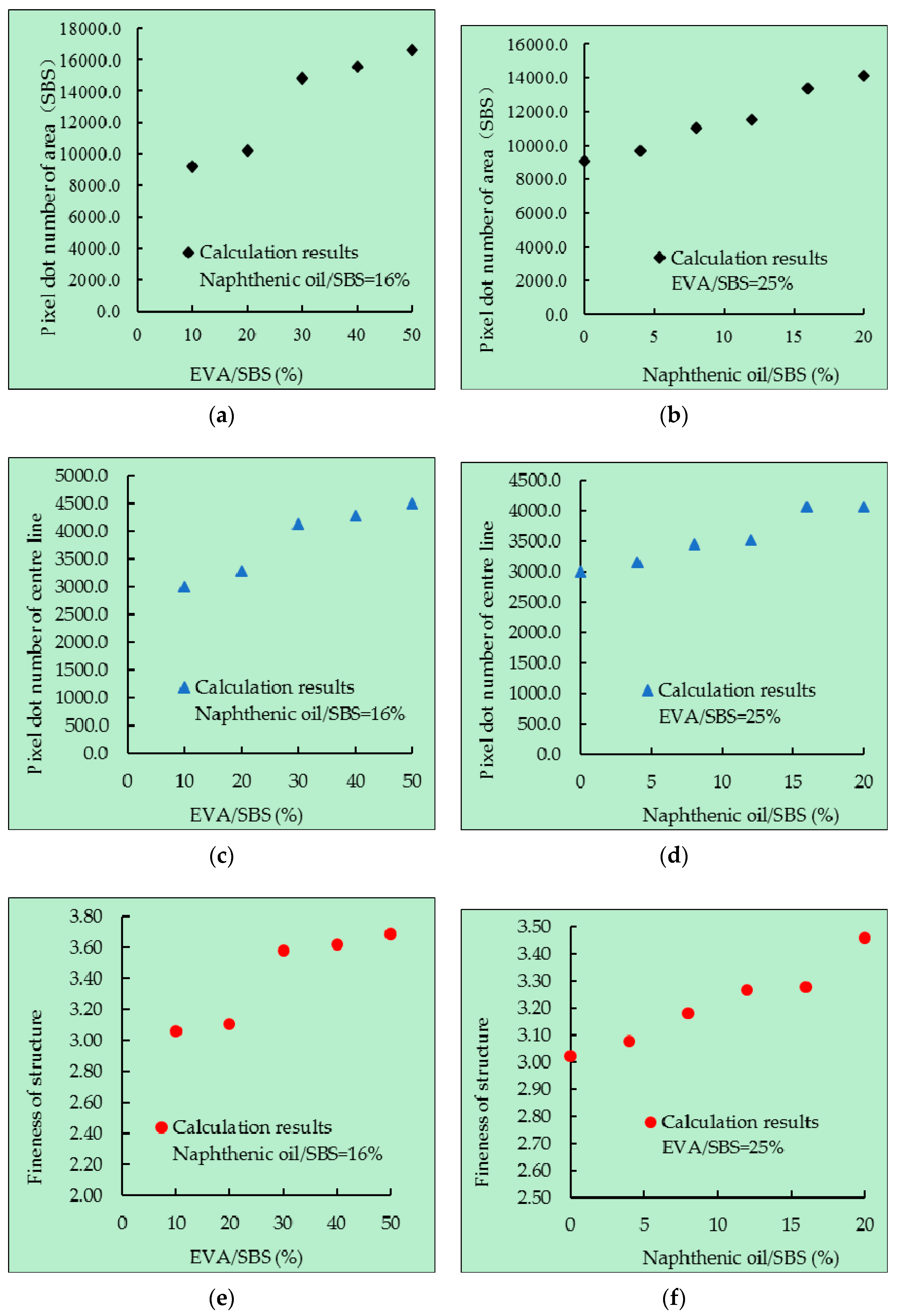

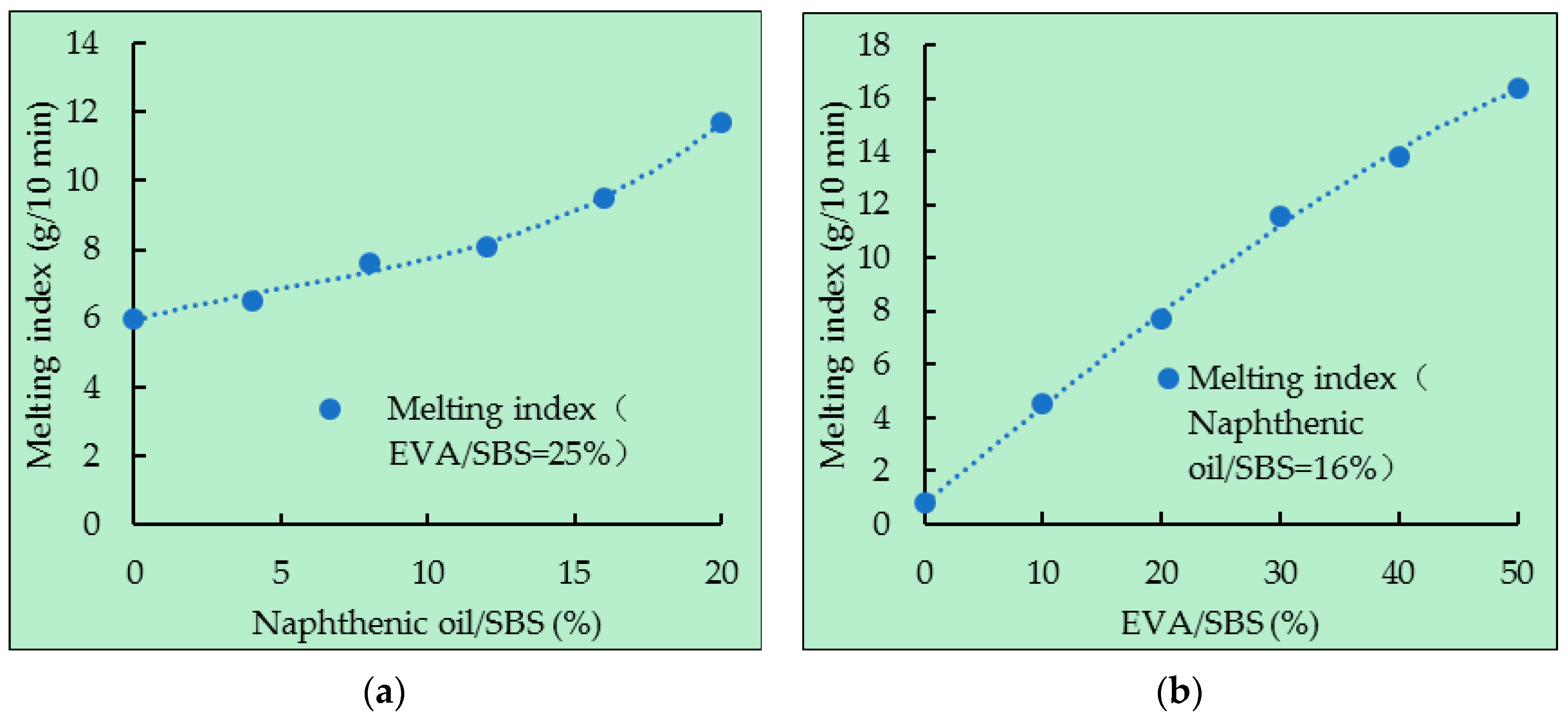

| Test | Unit | Measured Value | Test Items | Unit | Measured Value |
|---|---|---|---|---|---|
| 60 °C Dynamic viscosity | Pa.s | 204.7 | Asphaltene | % | 11.1 |
| 10 °C Ductility | cm | 56.9 | Saturate | % | 18.3 |
| 15 °C Ductility | cm | >100 | Aromatic | % | 40.7 |
| 15 °C Density | g/cm3 | 0.997 | Resin | % | 29.9 |
| Softening point | °C | 48.6 | 25 °C Penetration | 0.1mm | 88.4 |
| RTFOT | Penetration ratio | % | 69.8 | ||
| Loss of quality | % | 0.7 | |||
| 10 °C Residue Ductility | cm | 19 | |||
| 15 °C Residue Ductility | cm | 23 | |||
| Aggregate and Filler | Technical Indicators | Measured Value | Technical Requirement [33] | Test Methods [34] | ||
|---|---|---|---|---|---|---|
| Expressway and Class-I Highway | Other Classified Highway | |||||
| Surface Layer | Other Layer | |||||
| Coarse aggregate | Crushed stone value (%) | 22.4 | ≤26 | ≤28 | ≤30 | T0316 |
| Worn stone vale (%) | 13.6 | ≤28 | ≤30 | ≤35 | T0317 | |
| Water absorption (%) | 0.9 | ≤2.0 | ≤3.0 | ≤3.0 | T0304 | |
| Flat and elongated particle (%) | 4 | ≤15 | ≤18 | ≤20 | T0314 | |
| Fine aggregate | Sand equivalent value (%) | 72 | ≥60 | ≥60 | ≥50 | T0334 |
| Angularity (%) | 49 | ≥30 | ≥30 | ---- | T0345 | |
| Methylene blue value (g/kg) | 23.7 | ≤25 | ≤25 | ---- | T0346 | |
| Sediment percentage (%) | 1.2 | ≤3 | ≤3 | ≤5 | T0333 | |
| Mineral filler | Hydrophilic coefficient | 0.89 | ≤1 | ≤1 | ≤1 | T0353 |
| Plasticity index | 3.1 | ≤4 | ≤4 | ≤4 | T0354 | |
| Moisture content (%) | 0.5 | ≤1 | ≤1 | ≤1 | T0103 | |
| Apparent density (t/m3) | 2.712 | ≥2.50 | ≥2.50 | ≥2.45 | T0352 | |
| No. of Modifier | SBS | EVA | Naphthenic Oil | Compatibilizer | BHT |
|---|---|---|---|---|---|
| 1# | 1 | 0 | 0.16 | 0.03 | 0.05 |
| 2# | 1 | 0.1 | 0.16 | 0.03 | 0.05 |
| 3# | 1 | 0.2 | 0.16 | 0.03 | 0.05 |
| 4# | 1 | 0.3 | 0.16 | 0.03 | 0.05 |
| 5# | 1 | 0.4 | 0.16 | 0.03 | 0.05 |
| 6# | 1 | 0.5 | 0.16 | 0.03 | 0.05 |
| 7# | 1 | 0.25 | 0 | 0.03 | 0.05 |
| 8# | 1 | 0.25 | 0.04 | 0.03 | 0.05 |
| 9# | 1 | 0.25 | 0.08 | 0.03 | 0.05 |
| 10# | 1 | 0.25 | 0.12 | 0.03 | 0.05 |
| 11# | 1 | 0.25 | 0.16 | 0.03 | 0.05 |
| 12# | 1 | 0.25 | 0.2 | 0.03 | 0.05 |
| 13# | 1 | 0 | 0 | 0.03 | 0.05 |
| Types of Modifiers | Pixel Dot Number of the White Area (SBS) | Pixel Sot Number of the Centre Line | Fineness of SBS Structure |
|---|---|---|---|
| 1# | -- | -- | -- |
| 2# | 9230.4 | 3013.7 | 3.06 |
| 3# | 10205.0 | 3286.3 | 3.11 |
| 4# | 14802.0 | 4132.8 | 3.58 |
| 5# | 15536.0 | 4285.3 | 3.63 |
| 6# | 16642.0 | 4510.4 | 3.69 |
| 7# | 9068.6 | 2998.1 | 3.02 |
| 8# | 9688.9 | 3148.5 | 3.08 |
| 9# | 11013.0 | 3460.8 | 3.18 |
| 10# | 11514.0 | 3524.5 | 3.27 |
| 11# | 13342.0 | 4069.6 | 3.28 |
| 12# | 14111.0 | 4079.1 | 3.46 |
| 13# | -- | -- | -- |
| No. | 1# | 2# | 3# | 4# | 5# | 6# | 7# | 8# | 9# | 10# | 11# | 12# | 13# | Technical Requirement of SBSI-C [33] | |
|---|---|---|---|---|---|---|---|---|---|---|---|---|---|---|---|
| Penetration (25 °C, 0.1 mm) | 57.6 | 62.7 | 66.3 | 67.9 | 69.5 | 72.1 | 61.8 | 65.3 | 65.7 | 66.1 | 66.5 | 67.4 | 89.6 | 60–80 | |
| Softening point (°C) | 81.0 | 74.8 | 66.7 | 57.1 | 49.6 | 43.9 | 66.7 | 64.2 | 63.3 | 63.1 | 62.6 | 62.3 | 47.9 | ≥55 | |
| Ductility (5 °C, cm) | 29.4 | 37.5 | 39.1 | 39.6 | 41.4 | 42.7 | 37.8 | 37.0 | 39.6 | 40.2 | 39.7 | 40.7 | 22.6 | ≥30 | |
| Viscosity (135 °C, Pa·s) | 1.777 | 1.703 | 1.614 | 1.497 | 1.374 | 1.291 | 1.566 | 1.571 | 1.586 | 1.591 | 1.608 | 1.647 | 1.103 | ≤3 | |
| RTFOT | Penetration ratio (%) | 84.3 | 79.6 | 78.3 | 80.7 | 82 | 79.9 | 80.2 | 78.2 | 80.1 | 80.4 | 79.6 | 79.4 | 68.7 | ≥60 |
| Mass loss (%) | 0.05 | 0.1 | 0.1 | 0.2 | 0.2 | 0.2 | 0.1 | 0.1 | 0.3 | 0.2 | 0.2 | 0.2 | 0.8 | ≤1.0 | |
| Residual ductility (5 °C, cm) | 18.3 | 23.8 | 24.1 | 26.5 | 27.3 | 29.8 | 24.1 | 25.7 | 25.6 | 26.1 | 26.8 | 27.4 | 12.3 | ≥20 | |
| Completely dissolved (Y/N) | N | Basic | Y | Y | Y | Y | Basic | Y | Y | Y | Y | Y | N | ---- | |
| No. | 1# | 2# | 3# | 4# | 5# | 6# | 7# | 8# | 9# | 10# | 11# | 12# | 13# | Performance Requirement [33] |
|---|---|---|---|---|---|---|---|---|---|---|---|---|---|---|
| VV (%) | 3.5 | 3.6 | 3.5 | 3.5 | 3.5 | 3.4 | 3.5 | 3.5 | 3.6 | 3.5 | 3.4 | 3.5 | 3.4 | 3–5 |
| MS’ (%) | 81 | 92 | 95 | 93 | 93 | 95 | 95 | 92 | 93 | 94 | 93 | 92 | 83 | 85 |
| TSR (%) | 78 | 93 | 89 | 93 | 92 | 90 | 86 | 90 | 92 | 94 | 95 | 94 | 76 | 80 |
| DS (times/mm) | 4658 | 6836 | 7133 | 7268 | 7336 | 7405 | 6875 | 7152 | 6937 | 7436 | 7250 | 7309 | 4403 | 2400 |
| εB, με | 2439 | 3469 | 3521 | 3617 | 3664 | 3702 | 3550 | 3558 | 3628 | 3589 | 3607 | 3676 | 2319 | 3000 |
© 2019 by the authors. Licensee MDPI, Basel, Switzerland. This article is an open access article distributed under the terms and conditions of the Creative Commons Attribution (CC BY) license (http://creativecommons.org/licenses/by/4.0/).
Share and Cite
Zhang, W.; Jia, Z.; Zhang, Y.; Hu, K.; Ding, L.; Wang, F. The Effect of Direct-to-Plant Styrene-Butadiene-Styrene Block Copolymer Components on Bitumen Modification. Polymers 2019, 11, 140. https://doi.org/10.3390/polym11010140
Zhang W, Jia Z, Zhang Y, Hu K, Ding L, Wang F. The Effect of Direct-to-Plant Styrene-Butadiene-Styrene Block Copolymer Components on Bitumen Modification. Polymers. 2019; 11(1):140. https://doi.org/10.3390/polym11010140
Chicago/Turabian StyleZhang, Wengang, Zhirong Jia, Yixia Zhang, Kui Hu, Longting Ding, and Fang Wang. 2019. "The Effect of Direct-to-Plant Styrene-Butadiene-Styrene Block Copolymer Components on Bitumen Modification" Polymers 11, no. 1: 140. https://doi.org/10.3390/polym11010140
APA StyleZhang, W., Jia, Z., Zhang, Y., Hu, K., Ding, L., & Wang, F. (2019). The Effect of Direct-to-Plant Styrene-Butadiene-Styrene Block Copolymer Components on Bitumen Modification. Polymers, 11(1), 140. https://doi.org/10.3390/polym11010140








